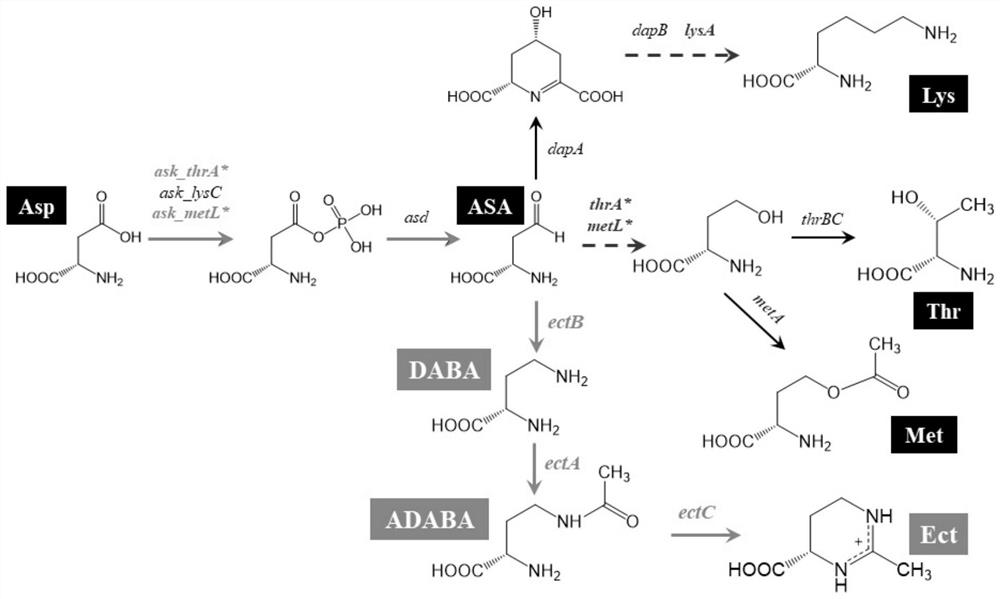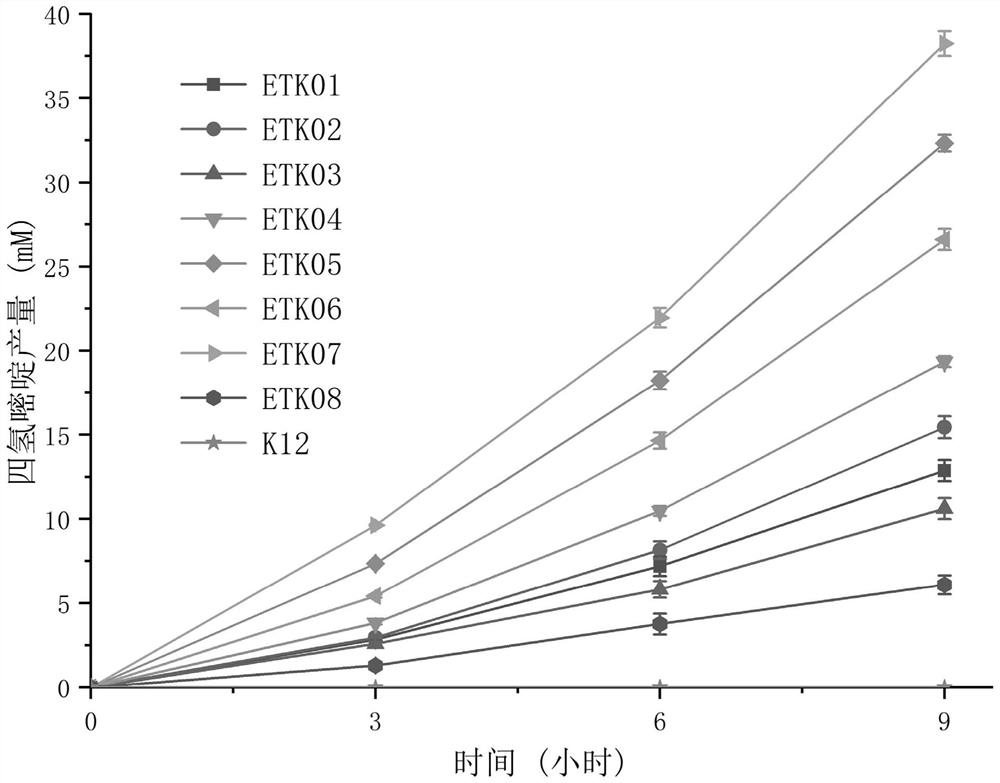Construction method and application of recombinant bacteria for producing ectoine
A technology of tetrahydropyrimidine and a construction method, which is applied in the field of genetic engineering and achieves the effects of high synthesis efficiency, good industrial application prospect and increased yield
- Summary
- Abstract
- Description
- Claims
- Application Information
AI Technical Summary
Problems solved by technology
Method used
Image
Examples
Embodiment 1
[0075] Embodiment 1 produces the construction of ectoine recombinant bacteria
[0076] 1. Construction of recombinant vector
[0077] The DNA sequence between the XhoI and BglII recognition sites of the pBADhisB vector is replaced with the DNA sequence for encoding diaminobutyric acid aminotransferase shown in SEQ ID No.12; the DNA sequence between the PstI and KpnI recognition sites is replaced by The DNA sequence for encoding diaminobutyric acid acetyltransferase shown in SEQ ID No.13; the DNA sequence between EcoRI and HindIII recognition sites is replaced by the DNA sequence for encoding tetrahydropyrimidine shown in SEQ ID No.14 The DNA sequence of the synthetase, and the other DNA sequences remained unchanged, and the recombinant vector PSKE was obtained; the identification of EctB, EctA and EctC genes was successfully inserted into the XhoI and HindIII recognition sites of the pBADhisB vector; the recombinant vector PSKE can express SEQ ID Diaminobutyric acid aminotran...
Embodiment 2
[0114] Embodiment 2 Recombinant bacteria transform L-sodium aspartate to produce ectoine
[0115] 1. Induction culture of recombinant bacteria
[0116] Streak the ectoine-producing recombinant bacteria ETK01, ETK02, ETK03, ETK04, ETK05, ETK06, ETK07, ETK08, and Escherichia coli K12 into LB containing agar with a mass concentration of 1.5% and ampicillin with a mass concentration of 100 μg / mL, respectively. Pick a single colony on the plate after culturing at 37°C for 12 hours, inoculate it into liquid LB medium containing ampicillin at a mass concentration of 100 μg / mL, and cultivate overnight at 37°C with shaking at 220 rpm; Inoculate the inoculum with a volume ratio of 1% into the self-inducing medium AYM, shake and culture at 200 rpm at 30°C for 16 hours, and obtain induced ETK01 strains, ETK02 strains, ETK03 strains, ETK04 strains, ETK05 strains, ETK06 strain, ETK07 strain, ETK08 strain and K12 strain.
[0117] 2. Recombinant bacteria transform sodium L-aspartate to prod...
Embodiment 3
[0120] The analysis of embodiment 3 recombinant bacterium ETK07 bacterial strains producing ectoine
[0121] 1. ETK07 strain transforms different L-aspartic acid salts to produce ectoine
[0122] Pick a single colony of ETK07 and inoculate it into liquid LB medium containing ampicillin with a mass concentration of 100 μg / mL, culture overnight at 37°C with shaking at 220 rpm; In a 2L fermenter of L self-inducing medium ZYM, with an aeration ratio of 1.2-1.5vvm, ferment at 30°C and a rotation speed of 700rpm for 18 hours to obtain a fermented liquid; then use a centrifuge to centrifuge the fermented liquid to collect ETK07 cells To a 1L transformation tank, add about 600mL of PBS buffer solution (pH7.0) to resuspend the strain to obtain a resuspended strain liquid, so that the content of the bacterial cells in the resuspended strain liquid is 15g / L based on the wet weight of the bacterial cell, and add to the resuspended strain liquid. Add glycerol and sodium L-aspartate or amm...
PUM
 Login to View More
Login to View More Abstract
Description
Claims
Application Information
 Login to View More
Login to View More - R&D
- Intellectual Property
- Life Sciences
- Materials
- Tech Scout
- Unparalleled Data Quality
- Higher Quality Content
- 60% Fewer Hallucinations
Browse by: Latest US Patents, China's latest patents, Technical Efficacy Thesaurus, Application Domain, Technology Topic, Popular Technical Reports.
© 2025 PatSnap. All rights reserved.Legal|Privacy policy|Modern Slavery Act Transparency Statement|Sitemap|About US| Contact US: help@patsnap.com



